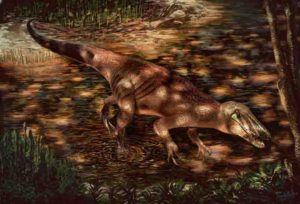
The new predatory dinosaur Tratayenia rosalesi crosses a stream in what is now Patagonia, Argentina roughly 85 million years ago.
Although many new dinosaur species have been discovered over the past few decades, entire groups of these animals remain shrouded in mystery. One of these is the Megaraptoridae, a shadowy pack of predators that terrorized South America and Australia during the middle and late stages of the Cretaceous Period – the third and final time period of the Age of Dinosaurs. Today, paleontologists announced the discovery of a never-before-seen member of this motley crew that casts light on the skeletal structure of megaraptorids and the roles they played in their long-vanished environments. Named Tratayenia rosalesi, the new species is based on fossil bones collected in Neuquén Province, Argentina – located in the northern part of the wild, windswept region of South America known as Patagonia. A study of the new creature—named after the locality where it was found, Tratayén, and its discoverer, Argentine fossil hunter Diego Rosales—was recently published in the scientific journal Cretaceous Research.
According to study leader Juan Porfiri of the Museo de Ciencias Naturales of the Universidad Nacional del Comahue in Neuquén, “When Diego told us about his find, we quickly got permission from the Dirección Provincial de Patrimonio Cultural del Neuquén to dig up the dinosaur. After we went to the site and began to unearth the bones, we got very excited because we thought we might have a megaraptorid.”
Says study co-author Domenica dos Santos, also of the Museo de Ciencias Naturales of the Universidad Nacional del Comahue, “Not many megaraptorid specimens are known, so we thought the new fossil would provide important information on these enigmatic predators.” Adds fellow co-author Rubén Juárez Valieri of the Museo Provincial Carlos Ameghino in Cipolletti, Argentina, “Patagonian discoveries such as Tratayenia are expanding our knowledge of the spectacular but still mysterious dinosaurs of the Southern Hemisphere.”
The new predatory dinosaur Tratayenia rosalesi crosses a stream in what is now Patagonia, Argentina roughly 85 million years ago.
Although many new dinosaur species have been discovered over the past few decades, entire groups of these animals remain shrouded in mystery. One of these is the Megaraptoridae, a shadowy pack of predators that terrorized South America and Australia during the middle and late stages of the Cretaceous Period – the third and final time period of the Age of Dinosaurs. Today, paleontologists announced the discovery of a never-before-seen member of this motley crew that casts light on the skeletal structure of megaraptorids and the roles they played in their long-vanished environments. Named Tratayenia rosalesi, the new species is based on fossil bones collected in Neuquén Province, Argentina – located in the northern part of the wild, windswept region of South America known as Patagonia. A study of the new creature—named after the locality where it was found, Tratayén, and its discoverer, Argentine fossil hunter Diego Rosales—was recently published in the scientific journal Cretaceous Research.
According to study leader Juan Porfiri of the Museo de Ciencias Naturales of the Universidad Nacional del Comahue in Neuquén, “When Diego told us about his find, we quickly got permission from the Dirección Provincial de Patrimonio Cultural del Neuquén to dig up the dinosaur. After we went to the site and began to unearth the bones, we got very excited because we thought we might have a megaraptorid.”
Says study co-author Domenica dos Santos, also of the Museo de Ciencias Naturales of the Universidad Nacional del Comahue, “Not many megaraptorid specimens are known, so we thought the new fossil would provide important information on these enigmatic predators.” Adds fellow co-author Rubén Juárez Valieri of the Museo Provincial Carlos Ameghino in Cipolletti, Argentina, “Patagonian discoveries such as Tratayenia are expanding our knowledge of the spectacular but still mysterious dinosaurs of the Southern Hemisphere.”
Still, scientists have much left to learn about megaraptorids. For one thing, their evolutionary relationships to other meat-eating dinosaurs are poorly understood, with some scientists arguing that megaraptorids are related to even larger Southern Hemisphere carnivores such as Carcharodontosaurus and Giganotosaurus, whereas others contend that megaraptorids are close cousins of T. rex. Though Tratayenia does not help to solve this particular riddle, an answer may well be in sight. According to Porfiri, “Tratayenia is just one of many exciting megaraptorid fossils that have been found in recent years. After these specimens are studied, many questions surrounding these puzzling meat-eaters may finally be answered.”
Reference:
Juan D. Porfiri et al. A new megaraptoran theropod dinosaur from the Upper Cretaceous Bajo de la Carpa Formation of northwestern Patagonia, Cretaceous Research (2018). DOI: 10.1016/j.cretres.2018.03.014
Note: The above post is reprinted from materials provided by Carnegie Museum of Natural History.










